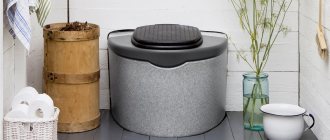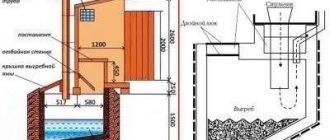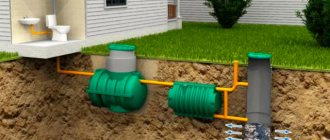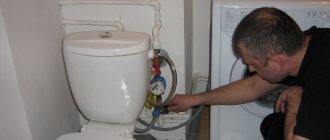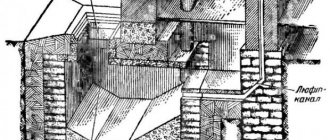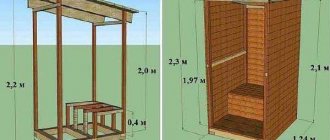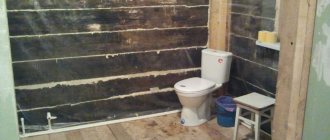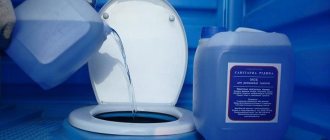Not all summer residents have the opportunity to make a full-fledged sewer system, and a developed environmental consciousness forces us to take care of waste recycling. The best option in this situation is a composting dry closet, in which waste is processed into compost. This article tells you how to make a dry closet with your own hands.
In the compost toilet bioreactor, waste is sprinkled with dry peat, which blocks odor and absorbs liquid. Biochemical reactions occur which cause the waste to decompose, releasing moisture and carbon dioxide and forming a small amount of compost.
It is this option that the summer residents of our portal consider the most harmless. Flush toilets require the use of chemical fluids.
Kisa Member of FORUMHOUSE
And in peat, besides peat and “this very thing,” there is nothing else.
Advantages and disadvantages of a composting toilet for a summer residence
A factory-made Finnish garden toilet has a huge range of advantages:
- with a small number of people living in the dacha, the storage tank fills slowly;
- low cost of peat and low consumption for backfilling;
- easy waste disposal;
- no odor provided there is working ventilation;
- the toilet seat is installed in any convenient place in the country house;
- models made of frost-resistant plastic are able to winter in outdoor cabins.
The peat dry closet also has weaknesses. Main disadvantages:
- Every owner of a peat dry closet is immediately faced with the problem of how the mechanism that spreads peat works. To make the powder crumble, turn the handle back and forth. However, even such a tedious procedure does not guarantee high-quality filling of all waste. The mechanism does not add peat under the toilet seat hole. You have to add the powder manually with a spatula. If this is not done, bad odors are guaranteed.
- The reservoir is equipped with a liquid drain. The hose connection is located high. The liquid will begin to drain when it reaches the desired level. Until this time, it accumulates, emitting an unpleasant odor. To speed up draining, the tank will have to be lifted and tilted manually.
- Solid organic waste accumulates under the opening of the toilet seat. They are not able to distribute themselves throughout the reservoir. The unpleasant procedure is performed manually with a spatula.
- If a peat dry closet has a large tank, it is difficult for one person to carry it out. You will need an assistant, but it is better to buy a model with wheels.
- Problems with ventilation do not arise when a peat dry closet is placed inside an outdoor cabin in the country. If you place a toilet seat in the house, it is advisable to have an exhaust fan, otherwise during the heat the room will be filled with bad aromas.
- Despite the light weight of the plastic toilet, the peat dry closet is considered a stationary structure. Move it to another place if there is an urgent need.
A composting toilet for a dacha has many disadvantages, but the design still surpasses the classic options with a cesspool in terms of comfort.
Advantages
Like any thing, a peat dry toilet has a number of positive qualities over its fellows, for example, over an outdoor toilet:
- The elegant appearance is almost identical to a regular toilet installed in an apartment.
- When using the structure, only organic substances are used, which, when decomposed, do not harm nature and the environment.
- The compost obtained as a result of using the toilet can be used in the garden and vegetable garden for fertilizer.
- The system has waste-free production.
- During waste processing, no unpleasant odor is released.
- Can be installed in a residential area.
- Complies with established sanitary standards.
- The structure can be installed inside a residential or country house, as well as in a separate building.
- Does not require complex additional maintenance or care.
- Easy to use and operate.
- In the manufacture of the structure's body, environmentally friendly material is used.
- The case material is resistant to frost and temperature changes.
The operating principle of peat toilets for a summer residence
The appearance of the product resembles a toilet with a tank, only instead of water, peat is filled inside the container. The spreader is a mechanism driven by a rotating handle. Sprinkle organic waste after each visit to the toilet.
Important! During powdering, you need to make sure that the peat completely covers all impurities.
The toilet has three names:
- Powder closet. The toilet is so called because of the method of powdering waste with peat.
- Composting toilet. Waste sprinkled with peat is suitable for making compost. There is a thermal toilet in which ready-made compost is formed inside the tank.
- Dry dry toilet. Waste after visiting the toilet is sprinkled with dry peat. The processed mass remains slightly moist upon unloading. This is where the third name came from.
Peat has good absorption properties. Natural material absorbs liquid that does not drain into the drain pan. Additionally, peat absorbs bad odors. In the waste mixed with the dry mass, beneficial microorganisms multiply, converting sewage into compost. Decomposed organic matter does not have a sharp unpleasant odor, but it cannot be used immediately for fertilizer. The waste must first be rotted in a compost heap for 1-2 years.
All peat dry closets are equipped with a ventilation outlet. Air ducts can be included with the toilet seat or purchased separately, depending on the model. The hood is installed 2 m high without turning. If it is not possible to install a straight pipe, the connection is made with elbows, and to improve draft the air duct is equipped with a fan.
In the video there is a peat toilet for a summer house with an exhaust fan:
Advantages and disadvantages
Like any product, a peat toilet has its advantages and disadvantages. Let's consider the main ones:
Advantages.
- When installing any device that handles human waste, water is needed, which means additional costs for connecting communications. In our case this problem does not exist. Water is not needed when using this type of toilet.
- Compared to other dry toilets, a peat toilet allows you to clean the tank less often than competitors.
- Waste after recycling not only does not pollute the environment, but allows you to save on fertilizer and bring benefits to the household.
- The price of the entire sewerage system is lower than its competitors.
- The only consumables required are peat, and this is a good saving on the maintenance of the facility.
- Almost complete absence of odors, thanks to the design and built-in ventilation.
Flaws.
- Installing a ventilation system can complicate construction work.
- Installing drainage creates additional problems when installing a toilet in a country house. Qualified specialists are required to work with the structure.
- After installation, the toilet cannot be moved to another place if it is a permanent structure. Read how to make a beautiful toilet stall with your own hands.
- Compared to other competitors on the market, it takes up more space.
Despite the presence of certain shortcomings, they can be attributed to installation features and can be quickly resolved by qualified personnel.
How to choose a peat toilet for your dacha
Factory-made composting toilets are designed almost identically, but there are differences in some nuances. When choosing a model for a summer residence, consider the following points:
- toilet seat height, toilet seat size;
- volume of the reservoir for the accumulation of sewage;
- equipped with an indicator for filling the tank with waste;
- permissible load on a plastic toilet seat.
You immediately need to think about where the toilet will be located in the dacha. The length of the drain hose and air ducts for ventilation are determined at the installation site.
Advice! When using a peat dry closet in winter in an outdoor cabin at the dacha, choose heated toilet seats.
Construction of a peat dry closet
From an aesthetic and visual point of view, a dry toilet is not much different from a regular toilet. Its design allows you to use it with comfort and convenience. A peat dry closet for a summer house or other building has the following design:
- Upper container. Used to store peat mixture in it. The peculiarity of the structure is that water is not used during operation. When you press the handle on the upper container, the mixture is poured into the lower container. The upper chamber in this case serves as a flushing system.
- Lower chamber, or storage tank. The average volume of a waste container is approximately 100-150 liters. This volume is sufficient for full use of the toilet by a family of 3-4 people. The lower container is necessary for collecting and accumulating human waste: feces and urine.
- Seat. Located above the lower chamber. Its main purpose is to create comfort and convenience during the operation of the structure.
- Ventilation. Like any room where there is a sewerage system, a dry closet must be equipped with a ventilation system. For this, the owners use a special pipe for ventilation. The ventilation kit for each model includes a clamp and a ventilation pipe.
It is worth noting that there are separate models of dry toilets for the elderly or for those who, for medical reasons, are prohibited from lifting heavy objects. The main distinguishing feature of such models is the wheels. With their help, the toilet can be easily rolled to the compost pit.
How to install a peat toilet in the country
The installation of a peat toilet at the dacha begins with unpacking the product and studying the instructions. The toilet seat is temporarily placed in a permanent place, holes are marked: in the wall for the drain hose and on the ceiling for the ventilation pipe.
After installation of communications, the product itself is installed. The toilet seat is fixed to the floor with screws. Peat purchased separately in a dacha bag for a peat toilet is poured inside the tank. The ventilation pipe and drain hose are attached to the outlet pipes. By turning the handle, the peat spreader mechanism is tested.
During installation, the most difficult process is arranging effective ventilation. For an outdoor booth in a dacha, the question is not critical. When installing indoors, correctly calculate the diameter of the air duct:
- a pipe with a cross-section of 40 mm will be enough if the residents of the dacha use the dry closet approximately 20 times a day;
- if the number of visits to the toilet reaches 60 times, install two air ducts with a diameter of 40 mm and 100 mm;
- when the amount of use exceeds 60 times a day, additional exhaust fans are installed with air ducts with a diameter of 40 mm and 60 mm.
The exact installation rules are specified in the instructions for each toilet model.
How does this dry toilet work?
This is a device in which waste is converted into biologically pure fertilizer with the help of special microorganisms. It can safely be called a dry toilet, unlike another type that uses chemicals. Peat containing microorganisms must be poured into a container. After backfilling, bacteria begin work on aerobic decomposition. As a result, the unpleasant odor disappears, so this toilet can be installed even inside the house. Sprinkling of peat filler is done using a special handle, which, turning in different directions, ensures uniform filling of the storage tank.
In a peat toilet, waste is converted into biologically pure fertilizer with the help of special microorganisms
Reviews about the use of such dry toilets are mostly positive.
We've been using it for three years now. The plastic is high quality and strong. Fortunately, my fears about the frost turned out to be unfounded. For three winters not a single crack appeared. You need to pour the peat mixture into the tank. But, frankly speaking, it is distributed very irrationally. That's why we use a box of mixture and a scoop. This makes it much more economical and simpler. An important nuance that must be taken into account during installation is that the floor should have a slight slope back. This is necessary so that the liquid flows freely into the drain. This design allows you to remove waste much less frequently - 1-2 times a month is quite enough.
tiggra2121
https://otzovik.com/review_6816163.html
The contents of the container really require emptying no more than once every 3-4 months. In addition, it may seem incredible, but the waste disposal process does not require water, and the ventilation system removes unpleasant odors inside the dry closet and dries its surface.
Kazak
https://farmerforum.ru/viewtopic.php?t=1083
Personally, I have only heard negative reviews. Such toilets are of no use; there is also an unpleasant smell. And where should it go if waste products are processed, even if some natural products are used.
serge
https://farmerforum.ru/viewtopic.php?t=1083&sid=907bee5958229b0ae20e94aa0020b2f1&start=10
Backfilling agents
Regular peat cannot be used for a dry closet - it contains too few necessary microorganisms. As backfill, you need purchased compounds that contain bacteria that process waste:
- for toilets with a volume of up to 50 l - peat filler;
- for large dry closets - peat mixed with sawdust, since sawdust is more breathable and composting of waste products occurs faster.
A peat toilet requires a special filler; ordinary garden peat is not suitable.
Division into factions
The best peat toilet is one in which waste is separated into liquid and solid fractions. The former are drained into a drainage ditch (and the smell of urine and feces disappears due to passage through the filler).
If you rarely use a peat toilet (no more than once a week), you can do without drainage, since a special filler absorbs urine and it has time to decompose. But if the device is used frequently or many people live in the country, drainage needs to be organized. The liquid is drained through a hose, passes through several filters and goes outside into a drain, compost pit, septic tank, or simply into the ground.
In an industrial peat toilet, waste is separated into liquid and solid fractions
In homemade toilets, as a rule, they do not make filters - it is too labor-intensive, the liquid is drained directly through the hose.
The solid fraction of waste under the influence of microorganisms turns into compost, which accumulates in the toilet container. It must be emptied periodically by pouring the resulting fertilizer into the compost bin. The resulting mass cannot be taken directly to the garden, since the full composting cycle takes two years. Empty the peat toilet as it fills: from once a week to once every three to four months. Since the filling tank is usually quite heavy, sometimes wheels are attached to it so that it can be rolled rather than dragged.
According to user reviews, it is better not to fill the toilet to the brim - the mass may be compressed and it will be more difficult to remove it.
Ventilation device
Such a toilet must have ventilation, otherwise bad odors will seep out of the container - after all, bacteria cannot process urine and feces instantly. In addition, for the life and activity of microorganisms, oxygen is needed.
A peat dry closet requires ventilation, as bacteria require oxygen to process urine and feces.
The ventilation pipe must be installed as straight and vertical as possible, since any rotation of it reduces air draft. Pipe dimensions:
- if the toilet is rarely used, you can get by with one 40 mm thick pipe for natural ventilation;
- in case of frequent use by a large family or frequent visits of guests, a 100 mm thick pipe and forced ventilation using an axial fan are needed.
Do-it-yourself peat toilet for the cottage
Looking at photos of homemade peat toilets at the dacha powder closet, it’s easy to visually develop a plan for making it yourself. To correctly decide on the design, first choose the location of the toilet in the dacha. The absence of a cesspool allows you to place the toilet seat anywhere. Usually, in a dacha, a room is allocated for a toilet inside the house or an outdoor stall is installed.
The toilet seat is made of wood. First, a rectangular timber frame is assembled. All sides are covered with plywood to form a box. A hole is cut out in the top shelf using a jigsaw. To finish it, it is convenient to use a plastic cover removed from an old toilet.
The storage tank is made from a plastic bucket. A hole is drilled from below, the fitting is fixed and a hose is put on to drain the liquid. The bucket is inserted inside the cut hole and covered tightly with a lid.
The toilet seat is fixed to the floor of a cubicle or designated room inside the house. An additional container with peat and a shovel is installed nearby. The drainage hose is led outside. Ventilation is provided in the room.
Price
The average price of the most popular models of composting peat toilets presented on the domestic market is:
- Finnish model Piteco-505 - from 5 thousand rubles;
- domestic model Biocomfort Plus - from 10 thousand rubles;
- domestic model “Compact-Elite” - from 3.5 thousand rubles;
- domestic model “Compact Lux-M” - from 4 thousand rubles;
- domestic model “Compact Premium” - from 4.5 thousand rubles;
- Swedish model Separett Villa-9000 - from 27 thousand rubles;
- Swedish model Violet Mulltoa-20 - from 55 thousand rubles.
Cost can vary significantly depending on design features. For example, peat tanks are characterized by a simpler design and small size storage tank, while a distinctive feature of duomatics is the presence of a pair of containers for collecting waste.
The most expensive ones include “thermo-structures”, equipped with special thermal insulation, as well as Biolans, which have special wheels for movement, drainage and ventilation systems.
If you do not want to build a full-fledged plumbing system in your dacha, buy or build a dry closet for your dacha. It is more comfortable than a regular pit, moreover, it is durable and does not emit odors.
The technology for making a feeder from cardboard boxes is described in this material.
Caring for a Finnish peat toilet for a summer residence
A peat dry closet will not take much time for the dacha owner to maintain. The whole process is based on removing the storage tank after it is filled. Waste is stored in a designated area. The compost obtained after 1-2 years is used to feed garden crops.
After emptying, the tank is washed. Water is used with the addition of detergents. Preparations are purchased specifically designed for composting toilets. They contain additional components that eliminate odor and facilitate the rapid processing of organic waste.
compost pit
The contents of peat toilets cannot be used immediately. It must be kept for some time in a compost pit, which you can make yourself or purchase a ready-made composter. It is better to purchase a garden composter that is not an open type, but one that closes with a lid.
To create a higher temperature, it makes sense to cover the waste with black textile material. This will speed up the process of obtaining high-quality compost.
The contents of the lower container of the peat toilet are emptied into the composter, after which it should be covered with earth. The decomposition processes will stop after about a year, and then the compost can be used as fertilizer.
Reviews of peat toilets for summer cottages
Real reviews help you choose a powder closet model for use in your dacha. Owners are happy to share their impressions of the purchased models.
Reviews of the Finnish peat toilet Ekomatik for the dacha
Vladimir Sergeevich Tulin, 39 years old, Aksai
Among many companies, Ekomatic was preferred. The toilet seat is made of high quality durable plastic. There are no gaps under the closed lid. The two of us live at the dacha. The tank can be removed once a season, but it’s better to remove it more often, otherwise it’s too heavy. I like the soft seat. The smell is practically inaudible.
Reviews of the Piteco 505 peat toilet for the garden
Valentina Petrovna Kogan, Alekseevka
Last spring I bought a Piteco peat toilet for my dacha and have not yet been disappointed with its performance. The quality of the plastic is normal. The downside is the exhaust pipes. They are slightly deformed in places. It didn’t work out to connect, so I bought new pipes. The toilet seat cover, about 5 mm, forms a gap between the body. I had to glue a rubber seal on the bottom. Otherwise I liked the purchase.
Reviews of the Finnish peat toilet Biolan for the dacha
Svetlana Aleksandrovna Ivanchenko, 30 years old, Alzamay
Two years ago we purchased a Finnish peat toilet Biolan with a capacity of 140 liters for our dacha. The purchase was successful, they placed it in an outdoor booth. In the Biolan Komplet model, all the details are thought out well, there are no cracks. My husband cleans the tank at the end of the season.
Evgeny Viktorovich Mukhin, 36 years old, Aprelevka
It’s good that I chose the Biolan peat toilet with a waste separator. There are no smells. Waste accumulates in two containers, which is very convenient for cleaning. The only negative I think is the high chair. I had to make a footrest.
Reviews of peat toilet Thermal toilet for a summer residence
Elena Anatolyevna Strizhenko, 38 years old, Artemovsk
I didn’t find any reviews about the L&T Termotoilet thermal toilet, so I bought it for luck. There are no complaints during the season of use. The waste actually turns into almost finished compost, but I still put it in a pile until the next season. I think energy independence is a plus. At the dacha, the electricity is often cut off, but the toilet continues to work. To obtain a positive effect, you must close the lid tightly.
Review of some models
Piteco 505. Features: has a well-thought-out liquid waste disposal system, removable storage. The container is emptied without moving the toilet or dismantling the drainage hose. The drainage hole has an anti-clogging filter that closes automatically when the container is lifted. There is a ventilation pipe and an improved peat spreading system. Dimensions - 71x39x59 cm. Price - approximately 5700 rubles.
Duomatic. Tank capacity 160 l. Features: has two storage tanks, a good ventilation system. Made from frost-resistant materials. There is a drainage system and ventilation. Dimensions - 90x78x87 cm. Price - about 42,000 rubles.
Peat. Capacity - 110 l. This is an analogue of the Finnish Ekomatic toilet. Made using Finnish technology and Finnish materials. Price - approximately 17,000 rubles.
Termo. Toilet capacity - 230 l. Features: has a spacious tank, a warm seat, and an additional thermal insulation layer that prevents waste from freezing. Price - about 28,500 rubles.
Ekomatic. Tank capacity - 110 l. Features: warm seat, adjustable ventilation, rubber gasket on the roof, peat feeding mechanism. Dimensions - 78x60x51 cm. Price - 18,000 rubles.
